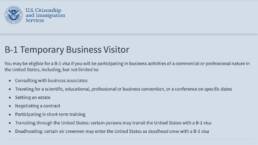The B-1 category allows individuals to enter the U.S. as business visitors. To qualify, you must prove the following:
- That you are entering to engage in permissible business activities;
- That your trip is temporary (typically six months or less);
- That you have sufficient funds to cover expenses; and
- That you have a residence and sufficient ties abroad that you do not intend to abandon.
Although the B-1 is commonly referred to as a “business” visa, it is not a work permit. B-1 status does not grant you the ability to perform labor or engage in employment in the U.S. Even answering work-related emails from your hotel room in New York could be considered a violation.
Permissible Business Activities
According to the regulations, only certain activities are permitted under the B-1 category. Permissible activities include attending meetings, conferences, or conventions; negotiating a contract; or settling an estate. Other business activities of this nature may also be allowed if you are not otherwise engaging in employment, such as participating in a voluntary service program or a short-term training course. There are also special provisions for certain classes of travelers, including domestic workers, independent researchers, commercial and industrial workers, and professional athletes.
How do you apply for B-1 status?
Generally, entering the U.S. in B-1 status is a two-step process. First, you must obtain a B-1 visa from a U.S. Embassy or Consulate abroad. Once a visa is issued, you must then travel to the U.S. and apply for admission with Customs and Broder Protection (CBP). The visa itself does not grant you entry to the States. CBP will still inspect you upon arrival and determine if you are eligible for B-1 status.
There are, however, exceptions to the visa requirement. For example, citizens of Canada are visa exempt, which means they don’t have to schedule and attend a visa interview before traveling to the U.S. Canadians need only a passport or other valid travel documents, such as a Nexus card, to apply for admission as a business visitor. In addition, the Visa Waiver Program permits citizens of 38 countries to travel to the U.S. temporarily for business without a visa. To travel under the Visa Waiver Program, however, you must apply for and obtain a valid ESTA and your trip to the U.S. will be limited to a maximum of 90 days.
If you are interested in applying for L-1 status on behalf of yourself or for one of your employees, please feel free to reach out via LinkedIn or send me an email at zahlstrom@usimmlawyer.com.
Published 5 November 2020
Ready to have Berardi on your side?
Whether you’re a business looking to hire or a professional hoping to relocate, immigration law can be complicated. But you don’t have to do it alone. Put our experience to work for you.



